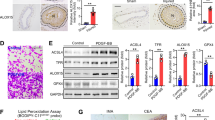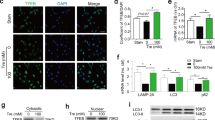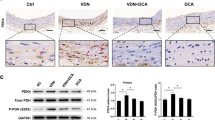Abstract
Phenotypic shift of vascular smooth muscle cells (VSMCs) plays a key role in intimal hyperplasia, especially in patients with diabetes mellitus (DM). This study aimed to investigate the role of dynamin-related protein 1 (DRP1) in mitochondrial fission-mediated VSMC phenotypic shift and to clarify whether DRP1 is the therapeutic target of isoliquiritigenin (ISL). Wire injury of carotid artery or platelet-derived growth factor treatment was performed in DM mice or high-glucose cultured human aortic smooth muscle cells (HASMCs), respectively. The effects of DRP1 silencing on DM-induced intimal hyperplasia were investigated both in vivo and in vitro. Phenotypic shift of HASMCs was evaluated by detection of reactive oxygen species (ROS) generation, cell viability, and related protein expressions. The effects of ISL on DM-induced intimal hyperplasia were evaluated both in vivo and in vitro. DRP1 silencing and ISL treatment attenuated DM-induced intimal hyperplasia with reduced ROS generation, cell viability, and VSMC dedifferentiation. The GTPase domain of DRP1 protein played a critical role in mitochondrial fission in DM-induced VSMC phenotypic shift. Cellular experiments showed that ISL inhibited mitochondrial fission and reduced the GTPase activity of DRP1, which was achieved by the directly binding to K216 of the DRP1 GTPase domain. ISL attenuated mouse intimal hyperplasia by reducing GTPase activity of DRP1 and inhibiting mitochondrial fission in vivo. In conclusion, increased GTPase activity of DRP1 aggregated DM-induced intimal hyperplasia by increasing mitochondrial fission-mediated VSMC phenotypic shift. ISL attenuated mouse intimal hyperplasia by reducing DRP1 GTPase activity and inhibiting mitochondrial fission of VSMCs.

This is a preview of subscription content, access via your institution
Access options
Subscribe to this journal
Receive 12 print issues and online access
$259.00 per year
only $21.58 per issue
Buy this article
- Purchase on Springer Link
- Instant access to full article PDF
Prices may be subject to local taxes which are calculated during checkout







Similar content being viewed by others
Data availability
The datasets used and/or analyzed during the current study are available from the corresponding author on reasonable request.
References
Tsao CW, Aday AW, Almarzooq ZI, Anderson CAM, Arora P, Avery CL, et al. Heart disease and stroke statistics-2023 update: a report from the American Heart Association. Circulation. 2023;147:e93–e621. https://doi.org/10.1161/cir.0000000000001123.
Goel SA, Guo LW, Liu B, Kent KC. Mechanisms of post-intervention arterial remodelling. Cardiovasc Res. 2012;96:363–71. https://doi.org/10.1093/cvr/cvs276.
Kornowski R, Mintz GS, Kent KM, Pichard AD, Satler LF, Bucher TA, et al. Increased restenosis in diabetes mellitus after coronary interventions is due to exaggerated intimal hyperplasia. A serial intravascular ultrasound study. Circulation. 1997;95:1366–9. https://doi.org/10.1161/01.cir.95.6.1366.
Kitoga M, Pasquet A, Preumont V, Kefer J, Hermans MP, Vanoverschelde JL, et al. Coronary in-stent restenosis in diabetic patients after implantation of sirolimus or paclitaxel drug-eluting coronary stents. Diabetes Metab. 2008;34:62–67. https://doi.org/10.1016/j.diabet.2007.09.002.
Kang SJ, Cho YR, Park GM, Ahn JM, Han SB, Lee JY, et al. Predictors for functionally significant in-stent restenosis: an integrated analysis using coronary angiography, IVUS, and myocardial perfusion imaging. JACC Cardiovasc Imaging. 2013;6:1183–90. https://doi.org/10.1016/j.jcmg.2013.09.006.
Sobel BE. Acceleration of restenosis by diabetes: pathogenetic implications. Circulation. 2001;103:1185–7. https://doi.org/10.1161/01.cir.103.9.1185.
Liao XH, Wang N, Zhao DW, Zheng DL, Zheng L, Xing WJ, et al. STAT3 protein regulates vascular smooth muscle cell phenotypic switch by interaction with myocardin. J Biol Chem. 2015;290:19641–52. https://doi.org/10.1074/jbc.M114.630111.
Cao T, Zhang L, Yao LL, Zheng F, Wang L, Yang JY, et al. S100B promotes injury-induced vascular remodeling through modulating smooth muscle phenotype. Biochim Biophys Acta Mol Basis Dis. 2017;1863:2772–82. https://doi.org/10.1016/j.bbadis.2017.07.002.
Rensen SS, Doevendans PA, van Eys GJ. Regulation and characteristics of vascular smooth muscle cell phenotypic diversity. Neth Heart J. 2007;15:100–8. https://doi.org/10.1007/bf03085963.
Bennett MR, Sinha S, Owens GK. Vascular smooth muscle cells in atherosclerosis. Circ Res. 2016;118:692–702. https://doi.org/10.1161/circresaha.115.306361.
Xi G, Shen X, Wai C, White MF, Clemmons DR. Hyperglycemia induces vascular smooth muscle cell dedifferentiation by suppressing insulin receptor substrate-1-mediated p53/KLF4 complex stabilization. J Biol Chem. 2019;294:2407–21. https://doi.org/10.1074/jbc.RA118.005398.
Peng W, Cai G, Xia Y, Chen J, Wu P, Wang Z, et al. Mitochondrial dysfunction in atherosclerosis. DNA Cell Biol. 2019;38:597–606. https://doi.org/10.1089/dna.2018.4552.
Chan DC. Mitochondrial dynamics and its involvement in disease. Annu Rev Pathol. 2020;15:235–59. https://doi.org/10.1146/annurev-pathmechdis-012419-032711.
Ding M, Feng N, Tang D, Feng J, Li Z, Jia M, et al. Melatonin prevents Drp1-mediated mitochondrial fission in diabetic hearts through SIRT1-PGC1α pathway. J Pineal Res. 2018;65:e12491 https://doi.org/10.1111/jpi.12491.
Yu T, Robotham JL, Yoon Y. Increased production of reactive oxygen species in hyperglycemic conditions requires dynamic change of mitochondrial morphology. Proc Natl Acad Sci USA. 2006;103:2653–8. https://doi.org/10.1073/pnas.0511154103.
Yu W, Wang X, Zhao J, Liu R, Liu J, Wang Z, et al. Stat2-Drp1 mediated mitochondrial mass increase is necessary for pro-inflammatory differentiation of macrophages. Redox Biol. 2020;37:101761 https://doi.org/10.1016/j.redox.2020.101761.
Rao GN, Berk BC. Active oxygen species stimulate vascular smooth muscle cell growth and proto-oncogene expression. Circ Res. 1992;70:593–9. https://doi.org/10.1161/01.res.70.3.593.
Wang L, Yu T, Lee H, O’Brien DK, Sesaki H, Yoon Y. Decreasing mitochondrial fission diminishes vascular smooth muscle cell migration and ameliorates intimal hyperplasia. Cardiovasc Res. 2015;106:272–83. https://doi.org/10.1093/cvr/cvv005.
Wang H, Robichaux WG, Wang Z, Mei FC, Cai M, Du G, et al. Inhibition of Epac1 suppresses mitochondrial fission and reduces neointima formation induced by vascular injury. Sci Rep. 2016;6:36552 https://doi.org/10.1038/srep36552.
Maimaitijiang A, Zhuang X, Jiang X, Li Y. Dynamin-related protein inhibitor downregulates reactive oxygen species levels to indirectly suppress high glucose-induced hyperproliferation of vascular smooth muscle cells. Biochem Biophys Res Commun. 2016;471:474–8. https://doi.org/10.1016/j.bbrc.2016.02.051.
Lee DG, Min JS, Lee HS, Lee DS. Isoliquiritigenin attenuates glutamate-induced mitochondrial fission via calcineurin-mediated Drp1 dephosphorylation in HT22 hippocampal neuron cells. Neurotoxicology. 2018;68:133–41. https://doi.org/10.1016/j.neuro.2018.07.011.
Lee DG, Nam BR, Huh JW, Lee DS. Isoliquiritigenin reduces LPS-induced inflammation by preventing mitochondrial fission in BV-2 microglial cells. Inflammation. 2021;44:714–24. https://doi.org/10.1007/s10753-020-01370-2.
Yerra VG, Kalvala AK, Kumar A. Isoliquiritigenin reduces oxidative damage and alleviates mitochondrial impairment by SIRT1 activation in experimental diabetic neuropathy. J Nutr Biochem. 2017;47:41–52. https://doi.org/10.1016/j.jnutbio.2017.05.001.
Nickel K, Zhu L, Mangalindan R, Snyder JM, Tucker M, Whitson J, et al. Long-term treatment with Elamipretide enhances healthy aging phenotypes in mice. Aging Pathobiol Ther. 2022;4:76–83.
Zhou C, Wang F, Ma H, Xing N, Hou L, Du Y, et al. Silencing of FOS-like antigen 1 represses restenosis via the ERK/AP-1 pathway in type 2 diabetic mice. Diabetes Vasc Dis Res. 2021;18:14791641211058855. https://doi.org/10.1177/14791641211058855.
Qi X, Qvit N, Su YC, Mochly-Rosen DA. novel Drp1 inhibitor diminishes aberrant mitochondrial fission and neurotoxicity. J Cell Sci. 2013;126:789–802. https://doi.org/10.1242/jcs.114439.
Cahill TJ, Leo V, Kelly M, Stockenhuber A, Kennedy NW, Bao L, et al. Resistance of dynamin-related protein 1 oligomers to disassembly impairs mitophagy, resulting in myocardial inflammation and heart failure. J Biol Chem. 2015;290:25907–19. https://doi.org/10.1074/jbc.M115.665695.
Janus A, Szahidewicz-Krupska E, Mazur G, Doroszko A. Insulin resistance and endothelial dysfunction constitute a common therapeutic target in cardiometabolic disorders. Mediat Inflamm. 2016;2016:3634948. https://doi.org/10.1155/2016/3634948.
Sasso FC, Pafundi PC, Marfella R, Calabrò P, Piscione F, Furbatto F, et al. Adiponectin and insulin resistance are related to restenosis and overall new PCI in subjects with normal glucose tolerance: the prospective AIRE Study. Cardiovasc Diabetol. 2019;18:24. https://doi.org/10.1186/s12933-019-0826-0.
Giustino G, Colombo A, Camaj A, Yasumura K, Mehran R, Stone GW, et al. Coronary in-stent restenosis: JACC state-of-the-art review. J Am Coll Cardiol. 2022;80:348–72. https://doi.org/10.1016/j.jacc.2022.05.017.
Yang L, Wang D, Zhang Z, Jiang Y, Liu Y. Isoliquiritigenin alleviates diabetic symptoms via activating AMPK and inhibiting mTORC1 signaling in diet-induced diabetic mice. Phytomedicine. 2022;98:153950. https://doi.org/10.1016/j.phymed.2022.153950.
Kalia R, Wang RY, Yusuf A, Thomas PV, Agard DA, Shaw JM, et al. Structural basis of mitochondrial receptor binding and constriction by DRP1. Nature. 2018;558:401–5. https://doi.org/10.1038/s41586-018-0211-2.
Wenger J, Klinglmayr E, Fröhlich C, Eibl C, Gimeno A, Hessenberger M, et al. Functional mapping of human dynamin-1-like GTPase domain based on x-ray structure analyses. PLoS ONE. 2013;8:e71835. https://doi.org/10.1371/journal.pone.0071835.
Schmitt K, Grimm A, Dallmann R, Oettinghaus B, Restelli LM, Witzig M, et al. Circadian control of DRP1 activity regulates mitochondrial dynamics and bioenergetics. Cell Metab. 2018;27:657–666.e655. https://doi.org/10.1016/j.cmet.2018.01.011.
Jin H, Jiang Y, Du F, Guo L, Wang G, Kim SC, et al. Isoliquiritigenin attenuates monocrotaline-induced pulmonary hypertension via inhibition of the inflammatory response and PASMCs proliferation. Evid Based Complement Alternat Med. 2019;2019:4568198. https://doi.org/10.1155/2019/4568198.
Chen T, Deng S, Lin R. The inhibitory effect of isoliquiritigenin on the proliferation of human arterial smooth muscle cell. BMC Pharmacol Toxicol. 2017;18:57. https://doi.org/10.1186/s40360-017-0165-2.
Qi J, Cui J, Mi B, Yan X, Xu W, Ma H, et al. Isoliquiritigenin inhibits atherosclerosis by blocking TRPC5 channel expression. Cardiovasc Ther. 2020;2020:1926249. https://doi.org/10.1155/2020/1926249.
Lin J, Wang F, Jiang G, Zhang T, Zhang J, He Q, et al. LXR activation ameliorates high glucose stress-induced aberrant mitochondrial dynamics via downregulation of Calpain1 expression in H9c2 cardiomyoblasts. Biochem Biophys Res Commun. 2022;614:145–52. https://doi.org/10.1016/j.bbrc.2022.05.025.
Chlystun M, Campanella M, Law AL, Duchen MR, Fatimathas L, Levine TP, et al. Regulation of mitochondrial morphogenesis by annexin A6. PLoS ONE. 2013;8:e53774. https://doi.org/10.1371/journal.pone.0053774.
Rambold AS, Kostelecky B, Elia N, Lippincott-Schwartz J. Tubular network formation protects mitochondria from autophagosomal degradation during nutrient starvation. Proc Natl Acad Sci USA. 2011;108:10190–5. https://doi.org/10.1073/pnas.1107402108.
Scott I, Youle RJ. Mitochondrial fission and fusion. Essays Biochem. 2010;47:85–98. https://doi.org/10.1042/bse0470085.
Sun CP, Zhou JJ, Yu ZL, Huo XK, Zhang J, Morisseau C, et al. Kurarinone alleviated Parkinson’s disease via stabilization of epoxyeicosatrienoic acids in animal model. Proc Natl Acad Sci USA. 2022;119:e2118818119. https://doi.org/10.1073/pnas.2118818119.
Franken H, Mathieson T, Childs D, Sweetman GM, Werner T, Tögel I, et al. Thermal proteome profiling for unbiased identification of direct and indirect drug targets using multiplexed quantitative mass spectrometry. Nat Protoc. 2015;10:1567–93. https://doi.org/10.1038/nprot.2015.101.
Zhang X, Wang Q, Li Y, Ruan C, Wang S, Hu L, et al. Solvent-induced protein precipitation for drug target discovery on the proteomic scale. Anal Chem. 2020;92:1363–71. https://doi.org/10.1021/acs.analchem.9b04531.
Funding
This work was supported by the National Natural Science Foundation of China (Nos. 82271336 and 81970694) and the Natural Science Foundation of Zhejiang Province (No. Y23H020027).
Author information
Authors and Affiliations
Corresponding author
Ethics declarations
Conflict of interest
The authors declare no competing interests.
Ethical approval
The Institute Research Medical Ethics Committee of the Second Affiliated Hospital of Wenzhou Medical University approved this study. All animal experiments were complied with the ARRIVE guidelines and were carried out following the U.S. Public Health Service Policy on Humane Care and Use of Laboratory Animals.
Additional information
Publisher’s note Springer Nature remains neutral with regard to jurisdictional claims in published maps and institutional affiliations.
Supplementary information
Rights and permissions
Springer Nature or its licensor (e.g. a society or other partner) holds exclusive rights to this article under a publishing agreement with the author(s) or other rightsholder(s); author self-archiving of the accepted manuscript version of this article is solely governed by the terms of such publishing agreement and applicable law.
About this article
Cite this article
Zhang, Bf., Wu, Zh., Chen, K. et al. Dynamin-related protein 1 mediates the therapeutic effect of isoliquiritigenin in diabetic intimal hyperplasia via regulation of mitochondrial fission. Hypertens Res (2024). https://doi.org/10.1038/s41440-024-01681-z
Received:
Revised:
Accepted:
Published:
DOI: https://doi.org/10.1038/s41440-024-01681-z



